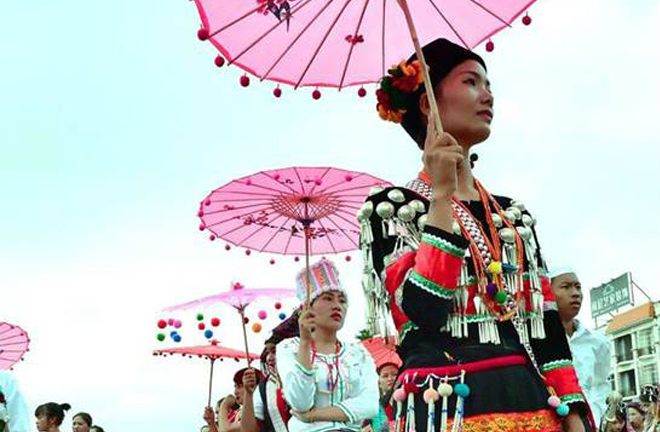China-Myanmar relations celebrate 70 years of pauk-phaw friendship

People celebrate the 19th China-Myanmar Paukphaw Friendship Carnival which opened in the border city of Ruili, southwest China’s Yunnan Province. Photo: CHINANEWS
This year marks the 70th anniversary of the establishment of diplomatic ties between China and Myanmar. Chinese President Xi Jinping paid a state visit to Myanmar on January 17 and 18 at the beginning of the year, which was Xi’s first visit to a foreign country in 2020. It has been nearly 20 years since his last visit to Myanmar, which is of special significance to relations between the two countries. The visit was a great success and the leaders of the two sides agreed to elevate their relations from what is characterized by a comprehensive strategic partnership to that by a community of shared future. The millennia-old pauk-phaw (Burmese, meaning brotherly) friendship between China and Myanmar has also entered a new phase.
Objectively, China and Myanmar have a unique geographical and humanistic bond. The two countries share not only 2,020 kilometers of land border, but also cross-border rivers such as the Irrawaddy River (its eastern source is China’s Dulong River), the Salween River (known as the Nu River in China) and the Mekong River (known as the Lancang River in China). Such natural geographical links make the countries inseparable. Most of the ethnic groups living in Myanmar today are people who migrated southwards from the Qinghai-Tibetan Plateau and Yungui Plateau in ancient times. Myanmar’s ethnic groups are closely related to many of the ethnic groups in southwest China, sharing the same source and habit. The natural ties of kinship are indivisible. Therefore, it is appropriate to define this relationship as the pauk-phaw friendship of siblings who share a mother.
Subjectively, the people of China and Myanmar have long been bound together. Myanmar won independence in 1948 and when the People’s Republic of China was founded in 1949, Myanmar was the first non-socialist country to recognize it, and the first to sign a land boundary treaty with China. Yangon of Myanmar was an important transit place for Chinese leaders going through to visit other countries in the 1950s and 1960s. Myanmar was also one of the sponsors that proposed to restore the legitimate seat of the People’s Republic of China in the United Nations in 1971. Since the establishment of diplomatic relations 70 years ago, the two countries have always shared weal and woe and become a model of harmonious relations between countries with different social systems.
After the National League for Democracy (NLD) of Myanmar came into power in 2016, China-Myanmar cooperation has made great progress in various fields, which has laid a solid realistic foundation for building a China-Myanmar community of shared future. Over the past four years with the NLD in power, the comprehensive strategic partnership between the two sides has been further developed with strengthened political mutual trust, deeper economic cooperation and closer cultural exchanges. The two have supported each other on major issues and cooperated in a more smooth way on international and regional affairs.
In the political sphere, mutual trust between the two countries is stronger than ever. After the state counselor of Myanmar Aung San Suu Kyi took office, she chose China as the first foreign country to visit in addition to ASEAN. She visited China many times and met with Xi at international conferences. Myanmar was one of the first countries to respond to the Belt and Road (B&R) initiative, and a steering committee chaired by Aung San Suu Kyi was set up to guide Myanmar’s participation in the B&R. In the economic field, the scope and depth of cooperation between the two countries have substantially expanded. China has been Myanmar’s largest trading partner and the country’s largest source of foreign investment. The facility, trade and finance connectivity between the two sides under the B&R framework have continued to intensify. In cultural exchange, cooperation has risen to a higher level and with more density. Studying in China and learning Chinese has become the pursuit of many young people in Myanmar. At the same time, 21 universities in China have opened a major in Burmese, and hundreds of Chinese students go to Myanmar universities to learn Burmese every year. Since 2018, the number of Chinese visitors to Myanmar has quadrupled. Closer communication has greatly promoted the mutual understanding of the people on both sides.
Therefore, it conforms to the trend of the times and meets the expectations of the two peoples to build the China-Myanmar community of shared future and elevate Sino-Myanmar relations into a new era. It can be predicted that the political mutual trust between the two countries will be further enhanced; cooperation on international and regional issues will be closer; economic cooperation, especially the construction of the China-Myanmar Economic Corridor, will continue to deepen; and folk exchanges will remain frequent. The two sides will continue to maintain close leadership contact and strengthen strategic communication. Friendly exchanges between the two countries’ legislature bodies, political parties and think-tanks will also continue.
Lu Guangsheng is from the Center for Peripheral Diplomacy Study at Yunnan University.
edited by BAI LE

 PRINT
PRINT CLOSE
CLOSE